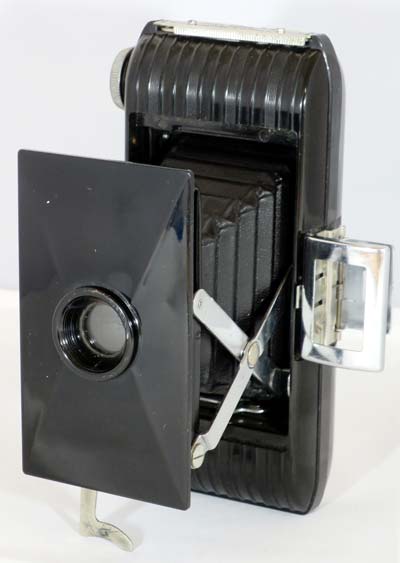Jiffy Kodak V.P.
Specification

| Manufacturer | : | Kodak |
|---|---|---|
| Produced | : | 1935 - 1942 |
| Classification | : | Medium Format |
| Body Type | : | Folding Strut |
| Construction | : | Bakelite |
| Film Type | : | 127 |
| Film Width | : | 46mm |
| ImageSize | : | 1⅝ x 2½ in |
| No. of Images | : | 8 |
| Lens Type | : | Doublet |
| Focus Type | : | Fixed |
| Focal Length | : | 70mm |
| Focal Range | : | 10ft - inf. |
| Aperture Type | : | Multihole |
| Aperture | : | f/11 and f/16 |
| Shutter Type | : | Jiffy V.P. |
| Shutter Speeds | : | T, I(1/50) sec |
| Size Closed (w x h x d) | : | 63 x 140 x 33 mm |
| Size Open (w x h x d) | : | 85 x 140 x 87 mm |
| Weight | : | 285g |
Art Deco Credentials
![]()
![]()
![]()
![]()
Significant: Pronounced and self evident
I consider this camera to warrant 4 stars for the following attributes:
- produced during the main Art Deco period
- designed by Walter Dorwin Teague
- Art Deco Streamline Moderne design
- Bakelite body with linear raised striped pattern
- shallow pyramid shape to lens plate
- chrome struts and pop-up finder
- horizontal lines and curved body enhancing the streamline effect.
Description
The camera body is made from moulded Bakelite plastic body with with linear raised striped pattern. The lens panel is also made from Bakelite and has a shallow piramid shape on it. The folding frame finder is chromed. It looks similar to Kodak Bantam f/6.3 model. The Streamline Moderne design was by Walter Dorwin Teague, a noted industrial design pioneer going back to the 1930's. Teague was responsible for the design of the famous Sparton table radios, a revamp of the Texaco gas station and logo, TWA identity and early Polaroid cameras. The streamlining effect was achieved by rounding the corners and by having no extraneous decoration.
How to Use
Find the User Manual here.
This camera takes 127 film which is still available from select outlets - search for 'Rera Pan 100-127' which is a black & white film. For those photographers in the UK, try Nick & Trick photographic services. If you want to use a particular type of film which is not available commercially, then you can cut your own 127 film from any 120 film. See my page on 'How to cut 127 film from 120 film'.
If you don't want to bother with an exposure meter, follow the guide shown. It is based on the 'Sunny 16' rule. Film is so forgiving and will produce acceptable results even when overexposed by 2 or 3 stops or underexposed by 1 stop.
Remember that the exposure guide in the camera user manual may not be helpful as it is based on the use of old film with a low ISO value.
The table assumes that the sun is at least 30 degrees above the horizon - that's 10am - 5pm on a summer's day in the UK.
If you are not sure about the light level, err on the side of overexposure - i.e. assume the smaller f number.
This camera has a choice of two aperture values - f/11 and f/16. The shutter speed is 1/50s
You may want to use a tripod to stop blur through shake.
Using ISO 100/125 film - shutter speed 1/50s
| Weather Conditions | Shadow Detail | Aperture | Exposure |
|---|---|---|---|
 Sunny SunnySnow/Sand | Dark with sharp edges | Tab Out f/16 | +2 Stop Overexposed Acceptable |
 Sunny Sunny | Distinct | Tab Out f/16 | +1 Stop Overexposed Acceptable |
 Slight Overcast Slight Overcast | Soft around edges | Tab Out f/16 | Good |
 Overcast Overcast | Barely visible | Tab In f/11 | Good |
 Heavy Overcast Heavy Overcast | None | Tab In f/11 | -1 Stop Underexposed Acceptable |
 Open Shade Open Shade/Sunset | None | Tab In f/11 | -2 Stop Underexposed Unacceptable |